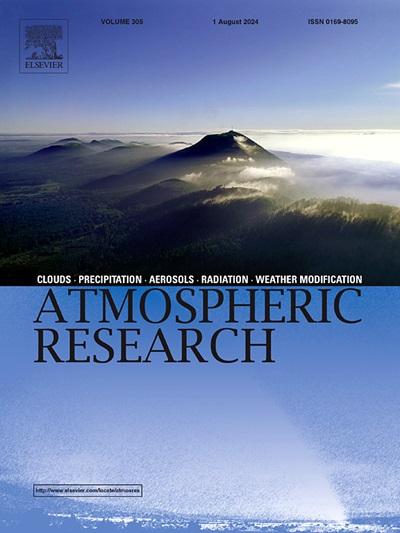IF 4.5
2区 地球科学
Q1 METEOROLOGY & ATMOSPHERIC SCIENCES
引用次数: 0
摘要
本文探讨了云的存在对天空辐射的影响。本文还分析了在使用针对无云大气设计的辐射传递模型(RTM)的反演算法时,云对气溶胶特性检索的影响。为此,考虑到 16 种不同的气溶胶情况,模拟了 9 种部分多云天空及其等效无云天空的合成观测数据。一个名为 "云增强因子"(CEF)的参数被用来确定相对于无云天空而言,每种部分多云情况对天空辐射的影响。该参数表明,应用云屏蔽后剩余的天空辐射量会受到云的影响。一般来说,与无云辐射相比,云辐射会增强 0% 到 20%,具体取决于多云条件和散射角。用于气溶胶特性检索的输入合成观测数据是所使用的反演策略 GRASPpac 所要求的:气溶胶光学深度(AOD)、4 个不同波长的天空辐射以及天文台范围校正信号(RCS)。在 CEFs 较低的部分多云情况下,气溶胶特性与无云条件相比没有显著变化。然而,在 CEFs 较高的部分多云情况下,有云和无云情况下的气溶胶光学特性有明显的差异。在这些情况下,两种条件下的检索精度相似,但多云条件下的精度较低。特别是在部分多云条件下,观察到实际折射率(RRI)和单散射反照率(SSA)分别高估了 0.05 至 0.06 之间和 0.03 至 0.06 之间,不对称系数(g)和虚折射率(IRI)分别低估了约 -0.02 和 -0.005。这些数值随气溶胶载荷和波长的变化而略有不同。这些参数对粒度分布参数的影响非常小,因此可以得出结论:云的影响在光学特性中非常明显,但在微物理特性中并不明显。本文章由计算机程序翻译,如有差异,请以英文原文为准。
Impact of cloud presence on sky radiances and the retrieval of aerosol properties
This paper explores the influence of the presence of clouds on sky radiances. It also analyses their impact on the retrieval of aerosol properties when using an inversion algorithm whose radiative transfer model (RTM) is designed for cloud-free atmospheres. For that, synthetic observations are simulated for 9 partially cloudy skies and for their equivalent cloud-free skies, considering 16 different aerosol scenarios. A parameter named cloud enhancement factor (CEF) has been used to determine the modifications induced in the sky radiances by each partially cloudy scenario with respect to the cloud-free sky. This parameter indicates that the sky radiances remaining after applying a cloud-screening are affected by the presence of clouds. In general, they show enhancements between 0 and 20 % with respect to the cloud-free radiances, depending on the cloudy conditions and the scattering angle. The synthetic observations used as input for the retrieval of aerosol properties are the ones required by the inversion strategy used, GRASP: the aerosol optical depth (AOD) and sky radiances at 4 different wavelengths together with the ceilometer range corrected signal (RCS). In partially cloudy scenarios with low CEFs, the aerosol properties do not present significant changes with respect to the cloud-free conditions. However, for partially cloudy scenarios with higher CEFs, a clear differentiation between the aerosol optical properties retrieved with and without clouds is observed. In these scenarios, the precision of the retrieval is similar for both conditions, but the accuracy is lower for the cloudy conditions. In particular, under partially cloudy conditions, it is observed an overestimation of the real refractive index (RRI) and the single scattering albedo (SSA) between 0.05 and 0.06 and between 0.03 and 0.06 respectively, and an underestimation of the asymmetry factor (g) and the imaginary refractive index (IRI) of about −0.02 and − 0.005, respectively. These values slightly vary with the aerosol load and wavelength for the RRI and SSA. The effects on the size distribution parameters are very small, concluding that the impact of clouds is noticeable in the optical properties but not so much in the microphysical part.
求助全文
通过发布文献求助,成功后即可免费获取论文全文。
去求助
来源期刊

Atmospheric Research
地学-气象与大气科学
CiteScore
9.40
自引率
10.90%
发文量
460
审稿时长
47 days
期刊介绍:
The journal publishes scientific papers (research papers, review articles, letters and notes) dealing with the part of the atmosphere where meteorological events occur. Attention is given to all processes extending from the earth surface to the tropopause, but special emphasis continues to be devoted to the physics of clouds, mesoscale meteorology and air pollution, i.e. atmospheric aerosols; microphysical processes; cloud dynamics and thermodynamics; numerical simulation, climatology, climate change and weather modification.
 求助内容:
求助内容: 应助结果提醒方式:
应助结果提醒方式:


